Mental Health Assignment 2022
VerifiedAdded on 2022/10/01
|7
|1774
|31
Assignment
AI Summary
Contribute Materials
Your contribution can guide someone’s learning journey. Share your
documents today.
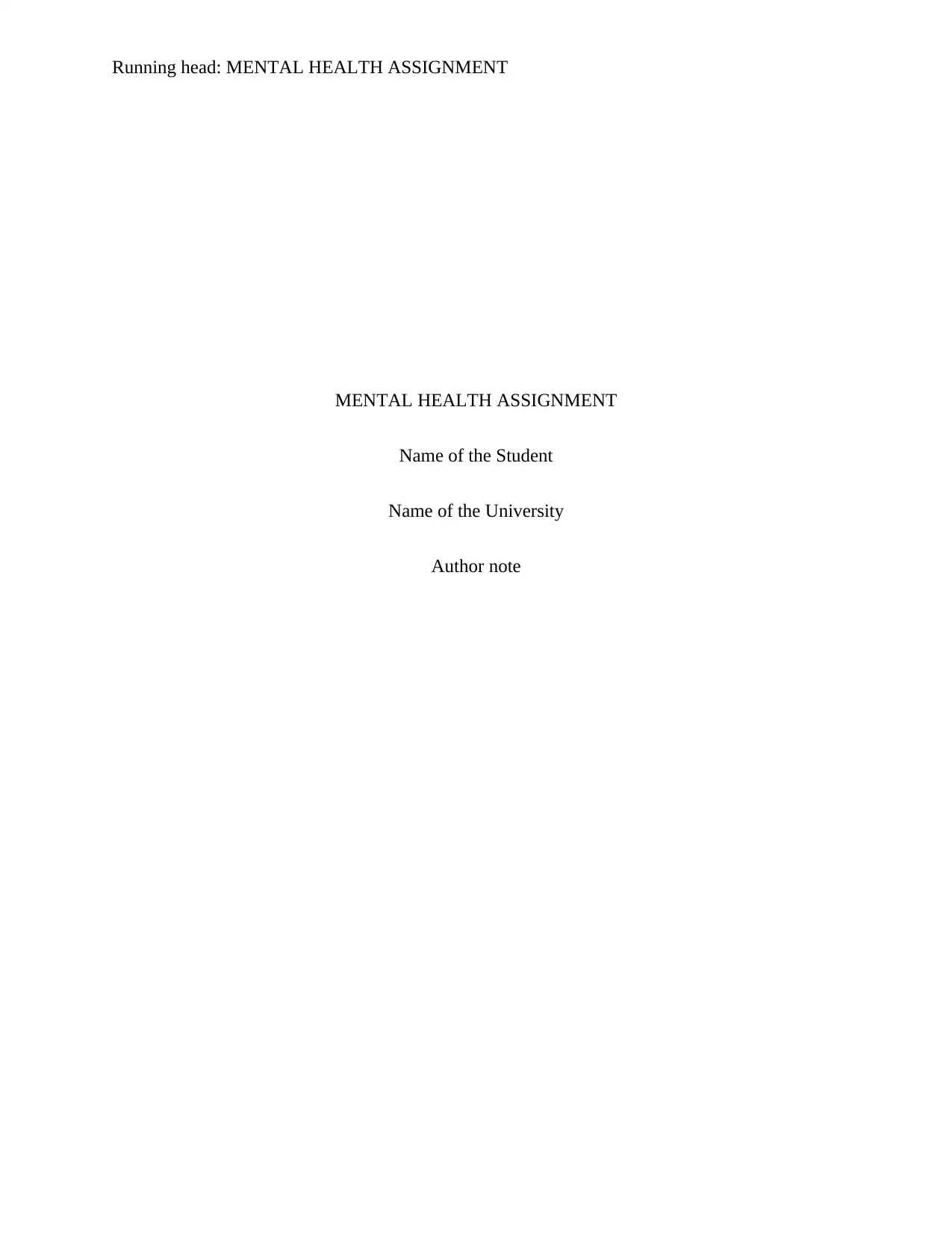
Running head: MENTAL HEALTH ASSIGNMENT
MENTAL HEALTH ASSIGNMENT
Name of the Student
Name of the University
Author note
MENTAL HEALTH ASSIGNMENT
Name of the Student
Name of the University
Author note
Secure Best Marks with AI Grader
Need help grading? Try our AI Grader for instant feedback on your assignments.
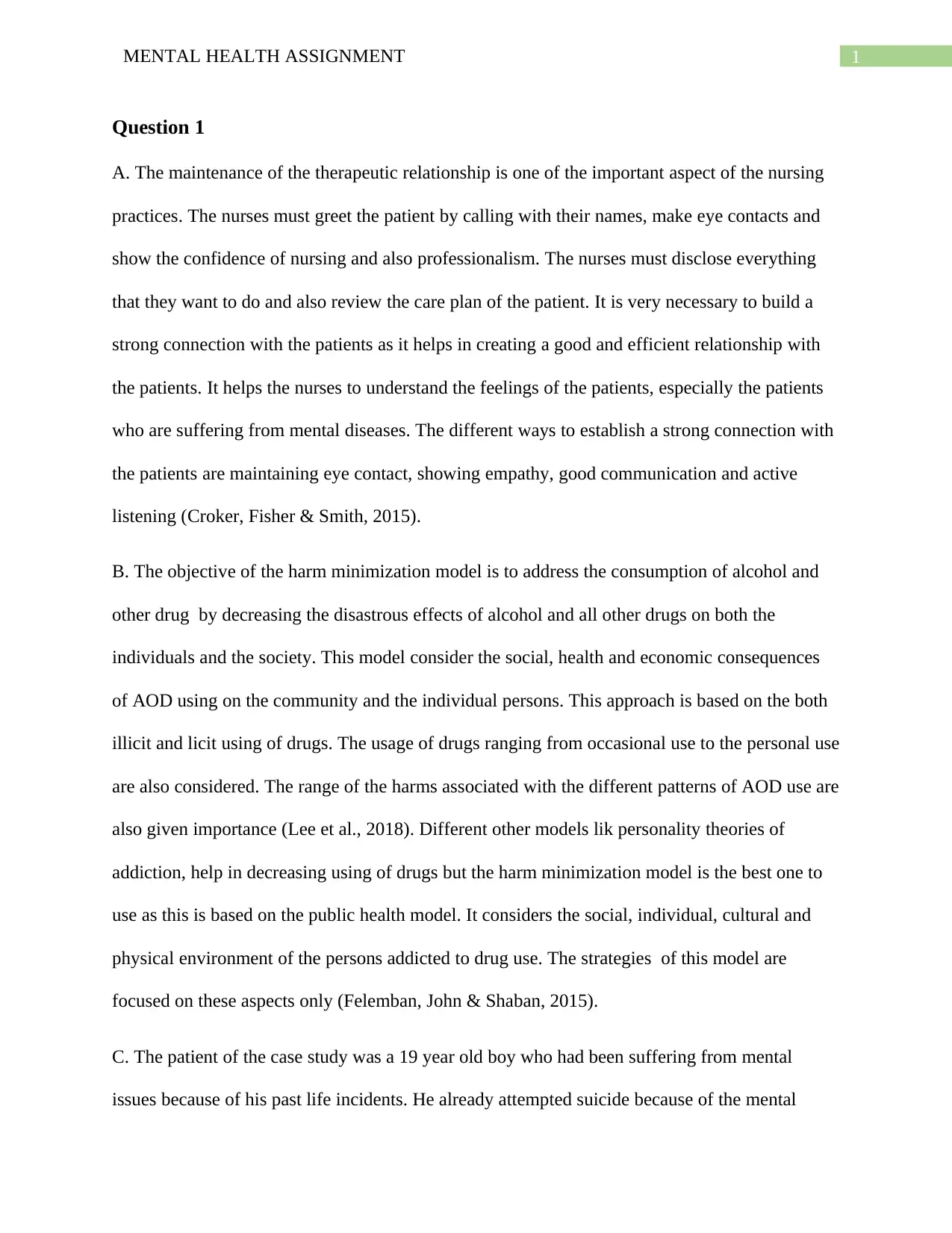
1MENTAL HEALTH ASSIGNMENT
Question 1
A. The maintenance of the therapeutic relationship is one of the important aspect of the nursing
practices. The nurses must greet the patient by calling with their names, make eye contacts and
show the confidence of nursing and also professionalism. The nurses must disclose everything
that they want to do and also review the care plan of the patient. It is very necessary to build a
strong connection with the patients as it helps in creating a good and efficient relationship with
the patients. It helps the nurses to understand the feelings of the patients, especially the patients
who are suffering from mental diseases. The different ways to establish a strong connection with
the patients are maintaining eye contact, showing empathy, good communication and active
listening (Croker, Fisher & Smith, 2015).
B. The objective of the harm minimization model is to address the consumption of alcohol and
other drug by decreasing the disastrous effects of alcohol and all other drugs on both the
individuals and the society. This model consider the social, health and economic consequences
of AOD using on the community and the individual persons. This approach is based on the both
illicit and licit using of drugs. The usage of drugs ranging from occasional use to the personal use
are also considered. The range of the harms associated with the different patterns of AOD use are
also given importance (Lee et al., 2018). Different other models lik personality theories of
addiction, help in decreasing using of drugs but the harm minimization model is the best one to
use as this is based on the public health model. It considers the social, individual, cultural and
physical environment of the persons addicted to drug use. The strategies of this model are
focused on these aspects only (Felemban, John & Shaban, 2015).
C. The patient of the case study was a 19 year old boy who had been suffering from mental
issues because of his past life incidents. He already attempted suicide because of the mental
Question 1
A. The maintenance of the therapeutic relationship is one of the important aspect of the nursing
practices. The nurses must greet the patient by calling with their names, make eye contacts and
show the confidence of nursing and also professionalism. The nurses must disclose everything
that they want to do and also review the care plan of the patient. It is very necessary to build a
strong connection with the patients as it helps in creating a good and efficient relationship with
the patients. It helps the nurses to understand the feelings of the patients, especially the patients
who are suffering from mental diseases. The different ways to establish a strong connection with
the patients are maintaining eye contact, showing empathy, good communication and active
listening (Croker, Fisher & Smith, 2015).
B. The objective of the harm minimization model is to address the consumption of alcohol and
other drug by decreasing the disastrous effects of alcohol and all other drugs on both the
individuals and the society. This model consider the social, health and economic consequences
of AOD using on the community and the individual persons. This approach is based on the both
illicit and licit using of drugs. The usage of drugs ranging from occasional use to the personal use
are also considered. The range of the harms associated with the different patterns of AOD use are
also given importance (Lee et al., 2018). Different other models lik personality theories of
addiction, help in decreasing using of drugs but the harm minimization model is the best one to
use as this is based on the public health model. It considers the social, individual, cultural and
physical environment of the persons addicted to drug use. The strategies of this model are
focused on these aspects only (Felemban, John & Shaban, 2015).
C. The patient of the case study was a 19 year old boy who had been suffering from mental
issues because of his past life incidents. He already attempted suicide because of the mental
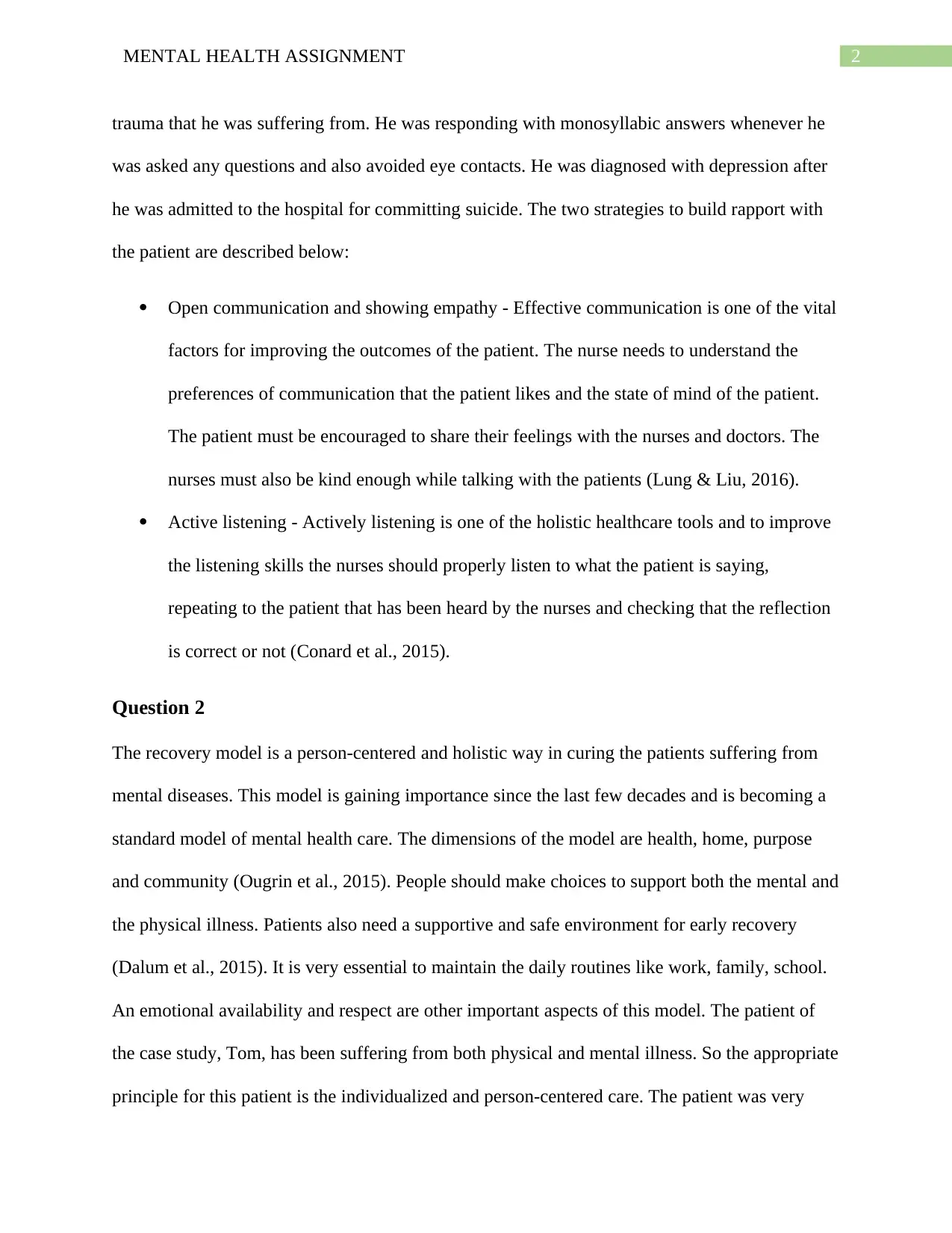
2MENTAL HEALTH ASSIGNMENT
trauma that he was suffering from. He was responding with monosyllabic answers whenever he
was asked any questions and also avoided eye contacts. He was diagnosed with depression after
he was admitted to the hospital for committing suicide. The two strategies to build rapport with
the patient are described below:
Open communication and showing empathy - Effective communication is one of the vital
factors for improving the outcomes of the patient. The nurse needs to understand the
preferences of communication that the patient likes and the state of mind of the patient.
The patient must be encouraged to share their feelings with the nurses and doctors. The
nurses must also be kind enough while talking with the patients (Lung & Liu, 2016).
Active listening - Actively listening is one of the holistic healthcare tools and to improve
the listening skills the nurses should properly listen to what the patient is saying,
repeating to the patient that has been heard by the nurses and checking that the reflection
is correct or not (Conard et al., 2015).
Question 2
The recovery model is a person-centered and holistic way in curing the patients suffering from
mental diseases. This model is gaining importance since the last few decades and is becoming a
standard model of mental health care. The dimensions of the model are health, home, purpose
and community (Ougrin et al., 2015). People should make choices to support both the mental and
the physical illness. Patients also need a supportive and safe environment for early recovery
(Dalum et al., 2015). It is very essential to maintain the daily routines like work, family, school.
An emotional availability and respect are other important aspects of this model. The patient of
the case study, Tom, has been suffering from both physical and mental illness. So the appropriate
principle for this patient is the individualized and person-centered care. The patient was very
trauma that he was suffering from. He was responding with monosyllabic answers whenever he
was asked any questions and also avoided eye contacts. He was diagnosed with depression after
he was admitted to the hospital for committing suicide. The two strategies to build rapport with
the patient are described below:
Open communication and showing empathy - Effective communication is one of the vital
factors for improving the outcomes of the patient. The nurse needs to understand the
preferences of communication that the patient likes and the state of mind of the patient.
The patient must be encouraged to share their feelings with the nurses and doctors. The
nurses must also be kind enough while talking with the patients (Lung & Liu, 2016).
Active listening - Actively listening is one of the holistic healthcare tools and to improve
the listening skills the nurses should properly listen to what the patient is saying,
repeating to the patient that has been heard by the nurses and checking that the reflection
is correct or not (Conard et al., 2015).
Question 2
The recovery model is a person-centered and holistic way in curing the patients suffering from
mental diseases. This model is gaining importance since the last few decades and is becoming a
standard model of mental health care. The dimensions of the model are health, home, purpose
and community (Ougrin et al., 2015). People should make choices to support both the mental and
the physical illness. Patients also need a supportive and safe environment for early recovery
(Dalum et al., 2015). It is very essential to maintain the daily routines like work, family, school.
An emotional availability and respect are other important aspects of this model. The patient of
the case study, Tom, has been suffering from both physical and mental illness. So the appropriate
principle for this patient is the individualized and person-centered care. The patient was very
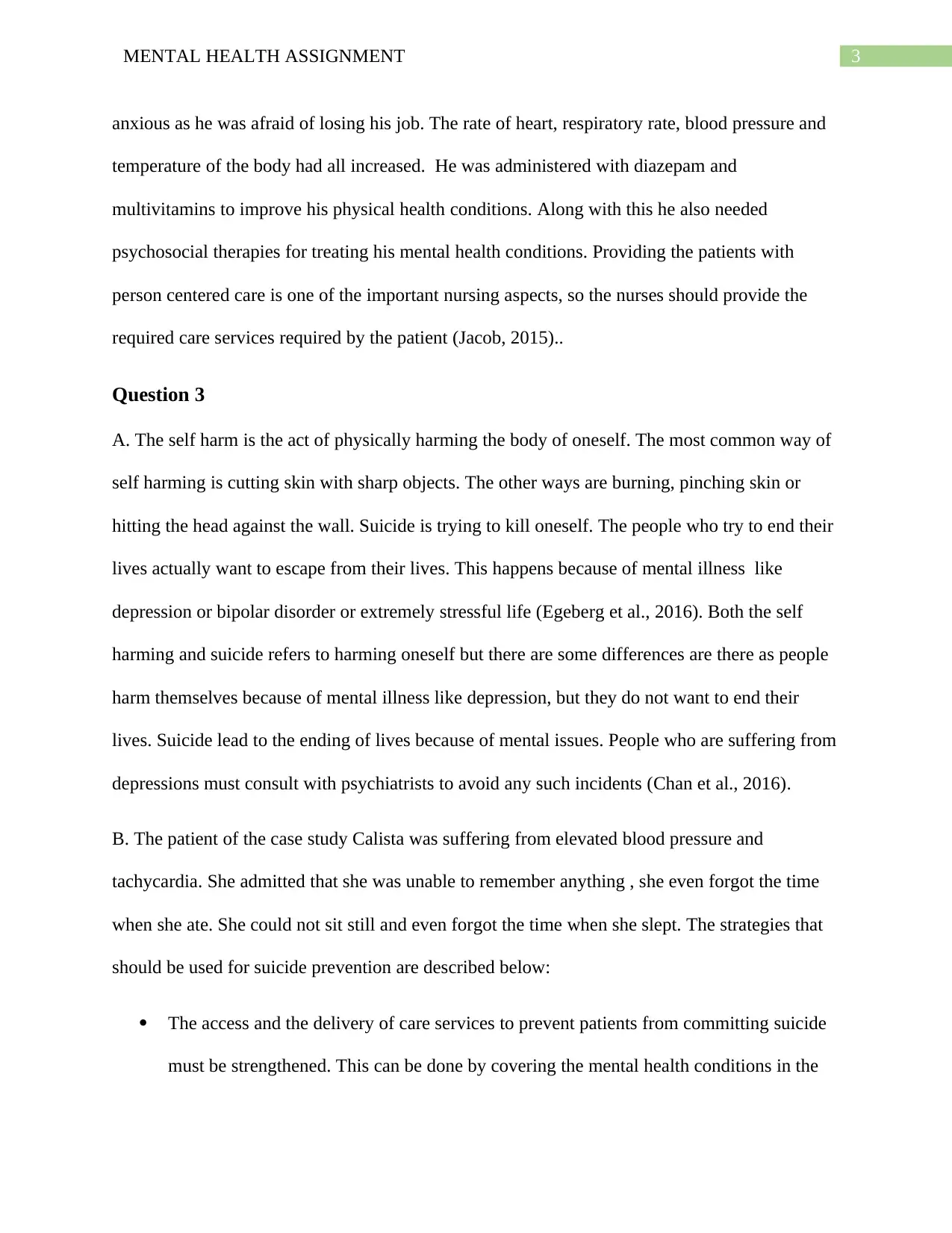
3MENTAL HEALTH ASSIGNMENT
anxious as he was afraid of losing his job. The rate of heart, respiratory rate, blood pressure and
temperature of the body had all increased. He was administered with diazepam and
multivitamins to improve his physical health conditions. Along with this he also needed
psychosocial therapies for treating his mental health conditions. Providing the patients with
person centered care is one of the important nursing aspects, so the nurses should provide the
required care services required by the patient (Jacob, 2015)..
Question 3
A. The self harm is the act of physically harming the body of oneself. The most common way of
self harming is cutting skin with sharp objects. The other ways are burning, pinching skin or
hitting the head against the wall. Suicide is trying to kill oneself. The people who try to end their
lives actually want to escape from their lives. This happens because of mental illness like
depression or bipolar disorder or extremely stressful life (Egeberg et al., 2016). Both the self
harming and suicide refers to harming oneself but there are some differences are there as people
harm themselves because of mental illness like depression, but they do not want to end their
lives. Suicide lead to the ending of lives because of mental issues. People who are suffering from
depressions must consult with psychiatrists to avoid any such incidents (Chan et al., 2016).
B. The patient of the case study Calista was suffering from elevated blood pressure and
tachycardia. She admitted that she was unable to remember anything , she even forgot the time
when she ate. She could not sit still and even forgot the time when she slept. The strategies that
should be used for suicide prevention are described below:
The access and the delivery of care services to prevent patients from committing suicide
must be strengthened. This can be done by covering the mental health conditions in the
anxious as he was afraid of losing his job. The rate of heart, respiratory rate, blood pressure and
temperature of the body had all increased. He was administered with diazepam and
multivitamins to improve his physical health conditions. Along with this he also needed
psychosocial therapies for treating his mental health conditions. Providing the patients with
person centered care is one of the important nursing aspects, so the nurses should provide the
required care services required by the patient (Jacob, 2015)..
Question 3
A. The self harm is the act of physically harming the body of oneself. The most common way of
self harming is cutting skin with sharp objects. The other ways are burning, pinching skin or
hitting the head against the wall. Suicide is trying to kill oneself. The people who try to end their
lives actually want to escape from their lives. This happens because of mental illness like
depression or bipolar disorder or extremely stressful life (Egeberg et al., 2016). Both the self
harming and suicide refers to harming oneself but there are some differences are there as people
harm themselves because of mental illness like depression, but they do not want to end their
lives. Suicide lead to the ending of lives because of mental issues. People who are suffering from
depressions must consult with psychiatrists to avoid any such incidents (Chan et al., 2016).
B. The patient of the case study Calista was suffering from elevated blood pressure and
tachycardia. She admitted that she was unable to remember anything , she even forgot the time
when she ate. She could not sit still and even forgot the time when she slept. The strategies that
should be used for suicide prevention are described below:
The access and the delivery of care services to prevent patients from committing suicide
must be strengthened. This can be done by covering the mental health conditions in the
Secure Best Marks with AI Grader
Need help grading? Try our AI Grader for instant feedback on your assignments.
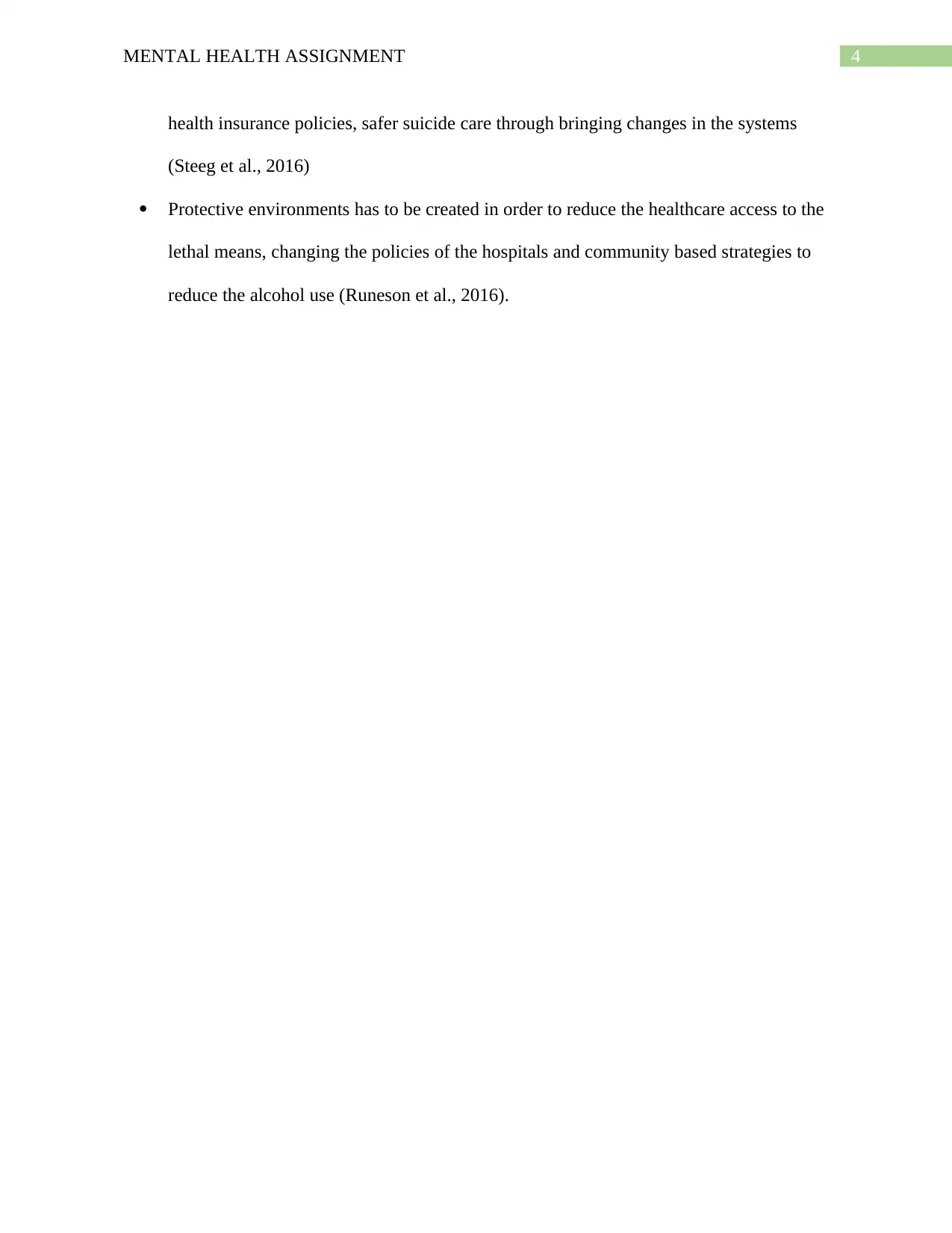
4MENTAL HEALTH ASSIGNMENT
health insurance policies, safer suicide care through bringing changes in the systems
(Steeg et al., 2016)
Protective environments has to be created in order to reduce the healthcare access to the
lethal means, changing the policies of the hospitals and community based strategies to
reduce the alcohol use (Runeson et al., 2016).
health insurance policies, safer suicide care through bringing changes in the systems
(Steeg et al., 2016)
Protective environments has to be created in order to reduce the healthcare access to the
lethal means, changing the policies of the hospitals and community based strategies to
reduce the alcohol use (Runeson et al., 2016).
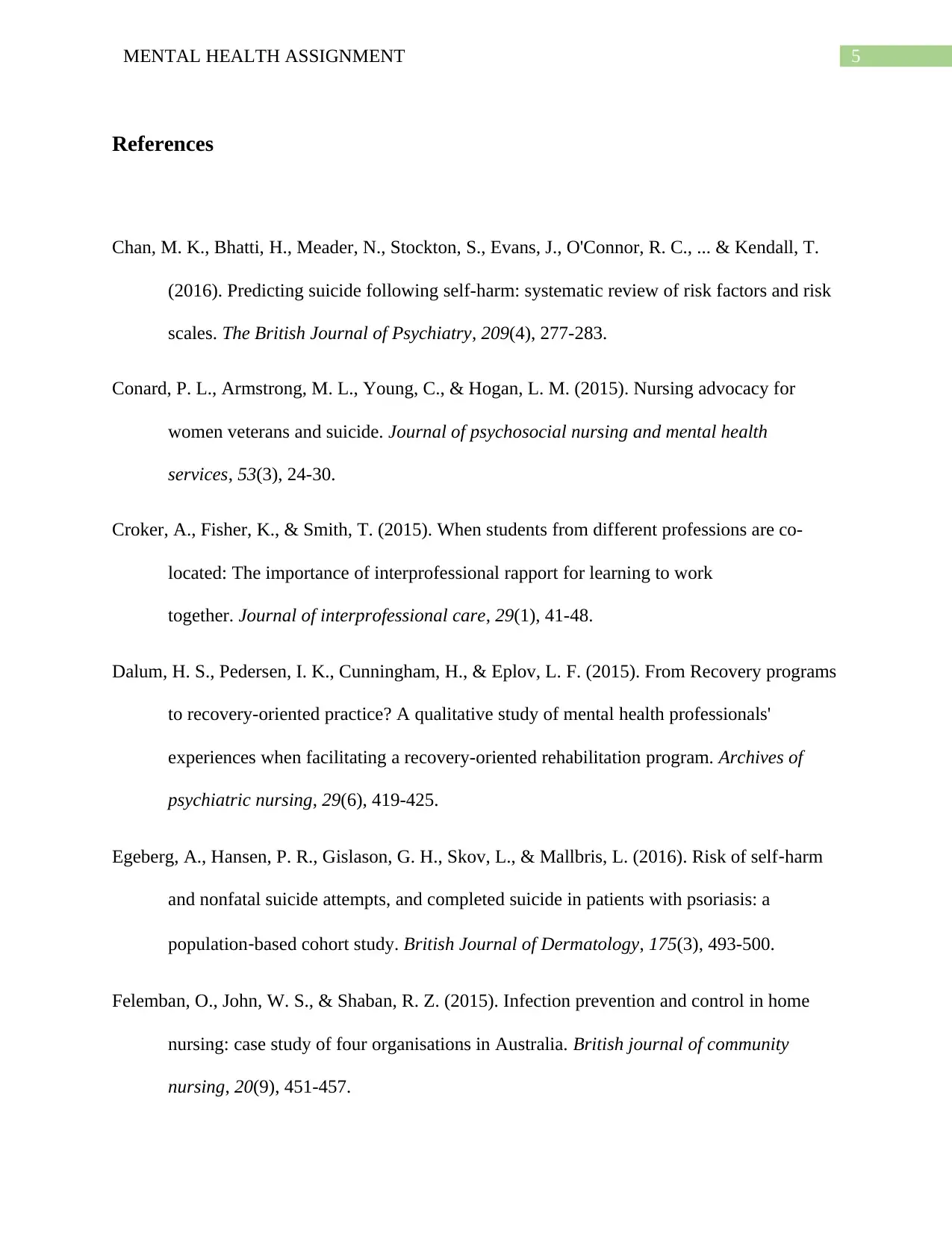
5MENTAL HEALTH ASSIGNMENT
References
Chan, M. K., Bhatti, H., Meader, N., Stockton, S., Evans, J., O'Connor, R. C., ... & Kendall, T.
(2016). Predicting suicide following self-harm: systematic review of risk factors and risk
scales. The British Journal of Psychiatry, 209(4), 277-283.
Conard, P. L., Armstrong, M. L., Young, C., & Hogan, L. M. (2015). Nursing advocacy for
women veterans and suicide. Journal of psychosocial nursing and mental health
services, 53(3), 24-30.
Croker, A., Fisher, K., & Smith, T. (2015). When students from different professions are co-
located: The importance of interprofessional rapport for learning to work
together. Journal of interprofessional care, 29(1), 41-48.
Dalum, H. S., Pedersen, I. K., Cunningham, H., & Eplov, L. F. (2015). From Recovery programs
to recovery-oriented practice? A qualitative study of mental health professionals'
experiences when facilitating a recovery-oriented rehabilitation program. Archives of
psychiatric nursing, 29(6), 419-425.
Egeberg, A., Hansen, P. R., Gislason, G. H., Skov, L., & Mallbris, L. (2016). Risk of self‐harm
and nonfatal suicide attempts, and completed suicide in patients with psoriasis: a
population‐based cohort study. British Journal of Dermatology, 175(3), 493-500.
Felemban, O., John, W. S., & Shaban, R. Z. (2015). Infection prevention and control in home
nursing: case study of four organisations in Australia. British journal of community
nursing, 20(9), 451-457.
References
Chan, M. K., Bhatti, H., Meader, N., Stockton, S., Evans, J., O'Connor, R. C., ... & Kendall, T.
(2016). Predicting suicide following self-harm: systematic review of risk factors and risk
scales. The British Journal of Psychiatry, 209(4), 277-283.
Conard, P. L., Armstrong, M. L., Young, C., & Hogan, L. M. (2015). Nursing advocacy for
women veterans and suicide. Journal of psychosocial nursing and mental health
services, 53(3), 24-30.
Croker, A., Fisher, K., & Smith, T. (2015). When students from different professions are co-
located: The importance of interprofessional rapport for learning to work
together. Journal of interprofessional care, 29(1), 41-48.
Dalum, H. S., Pedersen, I. K., Cunningham, H., & Eplov, L. F. (2015). From Recovery programs
to recovery-oriented practice? A qualitative study of mental health professionals'
experiences when facilitating a recovery-oriented rehabilitation program. Archives of
psychiatric nursing, 29(6), 419-425.
Egeberg, A., Hansen, P. R., Gislason, G. H., Skov, L., & Mallbris, L. (2016). Risk of self‐harm
and nonfatal suicide attempts, and completed suicide in patients with psoriasis: a
population‐based cohort study. British Journal of Dermatology, 175(3), 493-500.
Felemban, O., John, W. S., & Shaban, R. Z. (2015). Infection prevention and control in home
nursing: case study of four organisations in Australia. British journal of community
nursing, 20(9), 451-457.
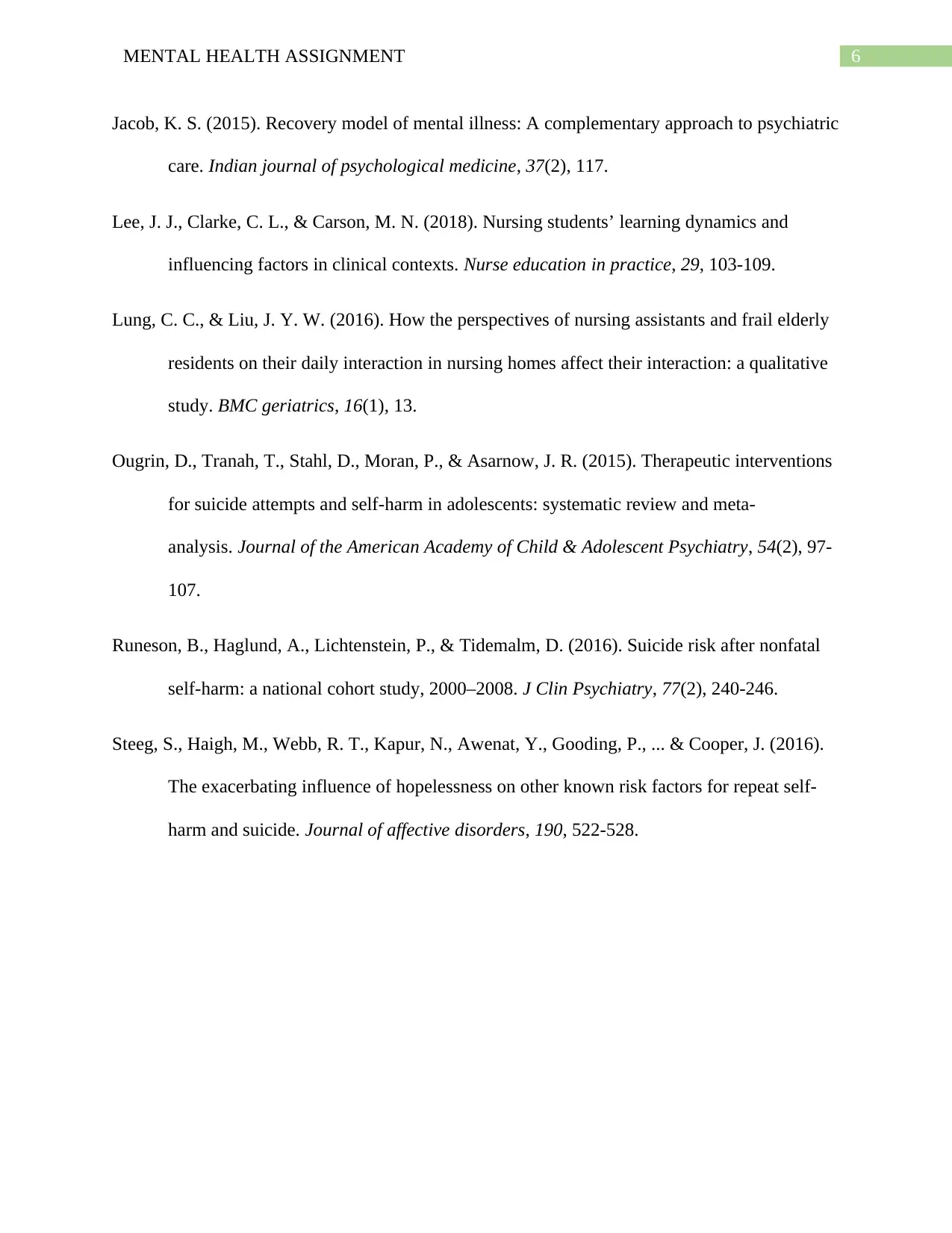
6MENTAL HEALTH ASSIGNMENT
Jacob, K. S. (2015). Recovery model of mental illness: A complementary approach to psychiatric
care. Indian journal of psychological medicine, 37(2), 117.
Lee, J. J., Clarke, C. L., & Carson, M. N. (2018). Nursing students’ learning dynamics and
influencing factors in clinical contexts. Nurse education in practice, 29, 103-109.
Lung, C. C., & Liu, J. Y. W. (2016). How the perspectives of nursing assistants and frail elderly
residents on their daily interaction in nursing homes affect their interaction: a qualitative
study. BMC geriatrics, 16(1), 13.
Ougrin, D., Tranah, T., Stahl, D., Moran, P., & Asarnow, J. R. (2015). Therapeutic interventions
for suicide attempts and self-harm in adolescents: systematic review and meta-
analysis. Journal of the American Academy of Child & Adolescent Psychiatry, 54(2), 97-
107.
Runeson, B., Haglund, A., Lichtenstein, P., & Tidemalm, D. (2016). Suicide risk after nonfatal
self-harm: a national cohort study, 2000–2008. J Clin Psychiatry, 77(2), 240-246.
Steeg, S., Haigh, M., Webb, R. T., Kapur, N., Awenat, Y., Gooding, P., ... & Cooper, J. (2016).
The exacerbating influence of hopelessness on other known risk factors for repeat self-
harm and suicide. Journal of affective disorders, 190, 522-528.
Jacob, K. S. (2015). Recovery model of mental illness: A complementary approach to psychiatric
care. Indian journal of psychological medicine, 37(2), 117.
Lee, J. J., Clarke, C. L., & Carson, M. N. (2018). Nursing students’ learning dynamics and
influencing factors in clinical contexts. Nurse education in practice, 29, 103-109.
Lung, C. C., & Liu, J. Y. W. (2016). How the perspectives of nursing assistants and frail elderly
residents on their daily interaction in nursing homes affect their interaction: a qualitative
study. BMC geriatrics, 16(1), 13.
Ougrin, D., Tranah, T., Stahl, D., Moran, P., & Asarnow, J. R. (2015). Therapeutic interventions
for suicide attempts and self-harm in adolescents: systematic review and meta-
analysis. Journal of the American Academy of Child & Adolescent Psychiatry, 54(2), 97-
107.
Runeson, B., Haglund, A., Lichtenstein, P., & Tidemalm, D. (2016). Suicide risk after nonfatal
self-harm: a national cohort study, 2000–2008. J Clin Psychiatry, 77(2), 240-246.
Steeg, S., Haigh, M., Webb, R. T., Kapur, N., Awenat, Y., Gooding, P., ... & Cooper, J. (2016).
The exacerbating influence of hopelessness on other known risk factors for repeat self-
harm and suicide. Journal of affective disorders, 190, 522-528.
1 out of 7
Related Documents
Your All-in-One AI-Powered Toolkit for Academic Success.
+13062052269
info@desklib.com
Available 24*7 on WhatsApp / Email
![[object Object]](/_next/static/media/star-bottom.7253800d.svg)
Unlock your academic potential
© 2024 | Zucol Services PVT LTD | All rights reserved.





